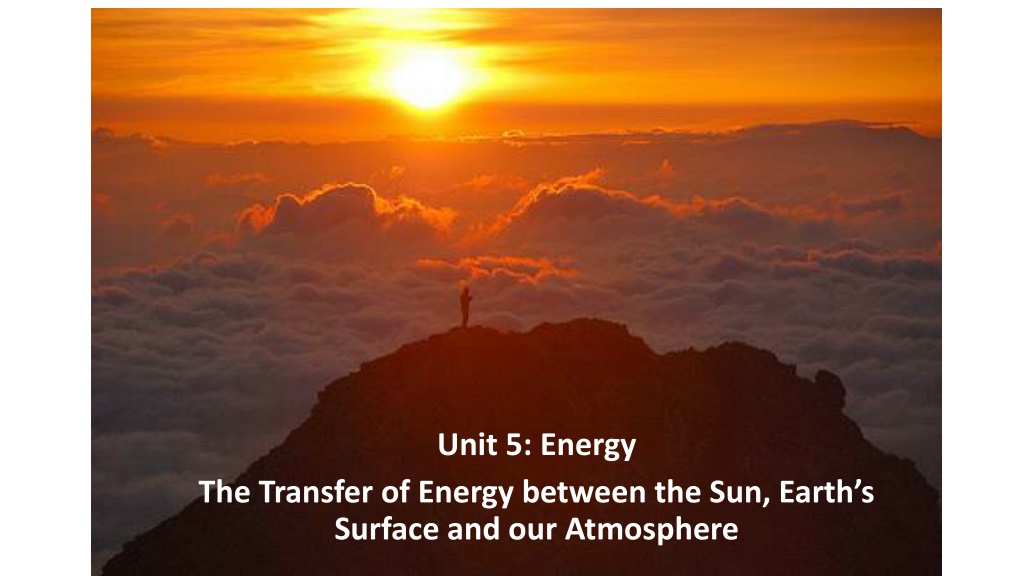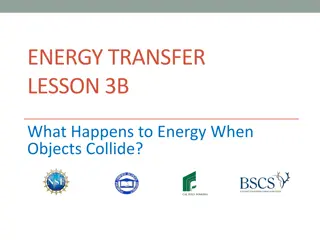Understanding Earth's Energy Transfer Processes
Earth's energy primarily comes from the Sun through various forms of electromagnetic radiation, such as visible light, infrared, and ultraviolet rays. This energy is absorbed and transferred through radiation, impacting factors like the angle of insolation and the type of surface receiving the energy. The Earth's core is even hotter than the Sun's surface due to initial planetary formation, showcasing the complexity of energy transfer on our planet.
Download Presentation

Please find below an Image/Link to download the presentation.
The content on the website is provided AS IS for your information and personal use only. It may not be sold, licensed, or shared on other websites without obtaining consent from the author. Download presentation by click this link. If you encounter any issues during the download, it is possible that the publisher has removed the file from their server.
E N D
Presentation Transcript
Unit 5: Energy The Transfer of Energy between the Sun, Earth s Surface and our Atmosphere
On Earth, there are three methods of heat transfer
Where does Earths energy come from? Where does Earth s energy come from? The temperature measured at Earth s central core (+6000 C) is actually inferred to be hotter than the sun s surface (~5600 C). This heat is largely due to the initial heat created from the planets formation (accretion/impacts). MOST of Earth s energy received at the surface is in the form of electromagnetic energy created by the Sun (ESRT pg. 14) Earth s magnetosphere and atmosphere filter out most of the high energy, short wavelength radiation (x-rays, gamma rays and most UV) Energy that makes it to Earth s surface is in the form of: Visible (ROYGBV) 44% Infrared (Heat) 48% Ultra Violet (UV) 7%
Radiation: Radiation: when energy is transferred through electromagnetic waves; requires no medium and can be transferred through any state of matter. How much energy can be absorbed by Earth s surface depends on a few factors: 1.) The angle at which the light is received 2.)The Type Surface (medium) absorbing the radiation
1.) The Angle of Insolation The Angle of Insolation (sun s angle): The angle at which the sun s rays strike the earths surface (measured from the horizon) Because the earth s surface is curved, all latitudes receive different angles of insolation. The higher the angle of insolation, the more energy absorbed by earth s surface.
2.) The type of surface receiving the energy The type of surface receiving the energy; Earth s surface varies by color, texture and medium surface varies by color, texture and medium Color- Would you rather walk barefoot on a dark asphalt surface in the middle of a hot summer day or a concrete sidewalk? i. Darker colored material will naturally absorb more solar energy compared to lighter material, but they will also cool down quicker Earth s Texture- Does still water on a lake portraying a perfect mirrored reflection absorb more or less energy than when it s surface is textured? ii. Roughness or smoothness of a surface affects the amount of energy absorbed. The rougher a surface, the more energy it will absorb and the less it will reflect.
Color and texture combine to create differing amounts of reflectivity on Earth s natural surfaces called ALBEDO ALBEDO Snow can reflect up to 95% of incoming solar energy (and absorb 5%) while Asphalt will reflect only 5% (and absorb 95%) Making a connection: Q: If glaciers continue to melt as global temperatures rise, how may that further contribute to a global temperature change?
iii. The type of medium; differential heating according The type of medium; differential heating according to to specific heat (pg. 1 of ESRT) specific heat (pg. 1 of ESRT) Specific Heat- That amount of heat needed to raise the temperature of one gram (g) of a substance by one degree Celsius. It takes 4.18 joules of energy to increase the temperature of water by 1 C but granitic rock (most continental crust) only 0.79 joules (less than 1/5 as much!) The relationship: the greater the specific heat of a substance, the greater the resistance to heating
Making the Making the connection connection: Why would Alaska have a greater seasonal range of temperature in regions inland compared to its coastal locations?
Objective: To test the amount of absorption of energy received via RADIATION with different variables Each group will test a different variable 1.) Color of material (light/dark, or natural colors in the environment) 2.) Texture of material (rough vs. smooth) 3.) Specific Heat of Material (different substances) Experiment Guidelines: i. All materials must be measured to have the same volume when tested ii. All material must be exposed to radiation for the same length of time iii. All material must be exposed to the same angle of radiation/distance from heat source during experiment (unless you are testing angle itself) iv. Data must be collected in intervals over a period of 10 minutes
Conduction: Transfer of heat from atom to atom when vibrating atoms or molecules collide. This can take place through any state of matter Making the connection: You are making a snowball in the winter. After rounding and compacting the ball, your hand feels virtually frozen. Why? The hotter a molecule is the faster it vibrates
Source to sink Heat transfer will only occur when two objects (or substances) have differential heating (different temperatures) Heat will always transfer from the heat source (higher temperature) to the heat sink (lower temperature) If not all energy is gained by the sink it has been lost to the environment (no transfer is 100% efficient!). All systems lose some heat energy during transfer Ex: energy required to heat up the substance itself (like a hot pan for cooking) or energy re-radiated by the substance after it is heated (your food cooling off)
Convection: The transfer of heat energy caused by differences in density (due to differences in temperature) Warm substances: are less dense than their cooler counterparts. This is because as a substance warms, the volume of the substance expands, due to the molecules moving further away from one another. Lower density means the substance will rise. Cooler substances: are more dense than their warmer counterparts. This is because as a substance cools, the volume of the substance contracts, due to the molecules moving closer together. Higher density means the substance will sink.
The Atmosphere and Convection *On Earth, warm air rises and cool air sinks. *Warmer air is less dense, and creates regions of lower pressure on earth *Cooler air is more dense and creates regions of higher pressure
Connections to Convection on Earth: Atmospheric Circulation from the equator to the poles
The Greenhouse Effect Earth s surface absorbs incoming short-waved ultraviolet and visible radiation as well as incoming long-wave infrared from the sun. Once energy is absorbed, earth re-radiates this energy in the form of only long wave infrared (heat) energy. If it weren t for greenhouse gases, the earth s average temperature would be below freezing (-18 C/0 F). An increase in greenhouse gases will cause global temperature averages to continue to rise, as more of earth s outgoing long-wave terrestrial radiation becomes trapped by our atmosphere.























